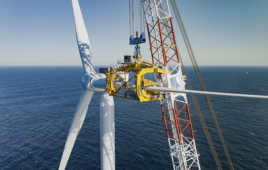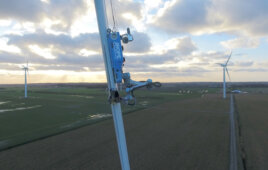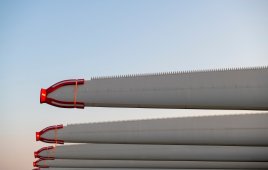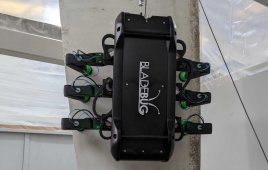 A CLEVERLY SIMPLE VIBRATION SENSOR made of a loop of thin fiber-optic cable and a fixed wavelength laser promises to take cost out of turbine-blade maintenance by letting owners spot problems as they occur. The device, already with two patents, won $150,000 for further development in New York’s PowerBridge competition. “This will let us form the start-up company, LazarOn, to package the sensor, mount it in a turbine, and prove the concept for the early detection of blade damage,” said Dr. Nikhil Gupta, technical lead for the company and Associate Professor of Mechanical and Aerospace Engineering at the NYU Tandon School of Engineering. After gearboxes, turbine blades have always generated the second most costly repairs.
A CLEVERLY SIMPLE VIBRATION SENSOR made of a loop of thin fiber-optic cable and a fixed wavelength laser promises to take cost out of turbine-blade maintenance by letting owners spot problems as they occur. The device, already with two patents, won $150,000 for further development in New York’s PowerBridge competition. “This will let us form the start-up company, LazarOn, to package the sensor, mount it in a turbine, and prove the concept for the early detection of blade damage,” said Dr. Nikhil Gupta, technical lead for the company and Associate Professor of Mechanical and Aerospace Engineering at the NYU Tandon School of Engineering. After gearboxes, turbine blades have always generated the second most costly repairs.
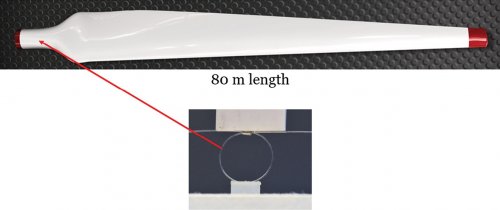
The LazarOn sensing element, 0.25-mm diameter fiber optic cable in a 6-mm loop, is easily mounted near a blade in the turbine hub or inside the root so it need not disrupt airflow as would other proposed blade sensors.
Although rare, a blade can break and fall if a growing fracture is undetected long enough. As with other wind-turbine equipment, detecting cracks and problems early enough makes repairs less expensive. “A preliminary market study found companies are trying to address the blade problem with more complex and expensive sensors, which need someone well versed with the technology. So a shortage of trained manpower would be a problem for them,” he said.
Furthermore, because the new design costs less to install than other monitors and requires no manpower to operate, it is far less expensive than ground-based visual and drone inspections, or the only close analog of Fiber Bragg Grating sensors. The latter use expensive tunable lasers and are costly to install and operate, and could be detrimental to blades due to sensor size. “That is not the case with our design,” said Gupta.
His sensor is made with a small thin optical fiber, about 0.25-mm dia. “This is standard optical fiber used in communications. The system works with fixed wavelength lasers, so the setup is not expensive, which is a big plus. We create a small loop out of this wire, about 6 to 8-mm diameter and mount it inside the hub. It does not have to be in the blade. Every rotating machine, turbine blades included, has a vibration signature. When damage such as a fracture starts, the signature changes, making the change detectable,” said Gupta. Also, a turbine works day and night making it possible to collects lots of data – which allows self-calibrating of each turbine.
It is not necessary to mount the sensor in the blade because its vibration is transmitted to the hub and column. “We have tested it in the lab and it is quite promising. The grant will let us take the next step to a turbine,” he added.
Gupta said that part of the PowerBridgeNY competition was to call 100 potential customers. So his team called companies in the U.S., China, Denmark, and India and found several willing to let him test the sensor. “The grant will pay for the sensor and we will not have to modify the turbine, so the cost of testing the sensor will be minimal to the wind power companies.”
As for a timeline, Gupta said the prototype must be finished by October of 2019. “We are hoping for data from at least one wind farm by then.”
Ideally, he said, manufacturers would put the sensor in the blade at the factory during production. “But before that, they might want full confidence in the technology. A first step is to retrofit existing blades, and then talk to manufacturers about embedding the sensors.” 
Filed Under: Blades, Sensors

